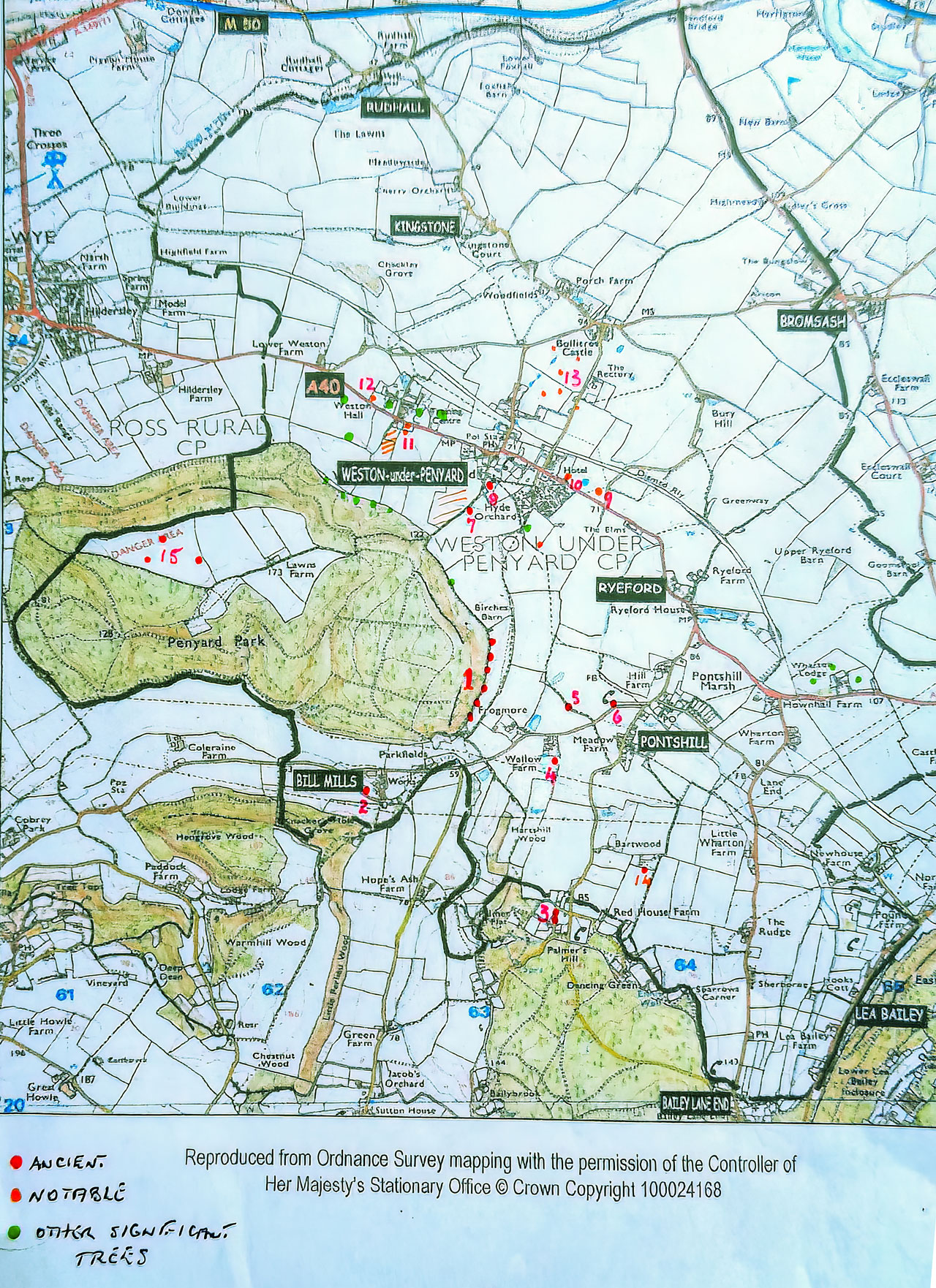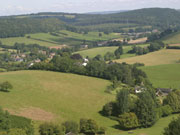Ancient, Veteran and Notable Trees in Weston Parish
Paul Rutter has been our Tree Officer in the Parish for many years, and we are very thankful to him for his service. He has recently moved away, but before doing so has helped to start an important piece of work for the parish, identifying trees that may be of interest to ensure that they are protected and looked after as part of our lovely local environment.
His report follows below, and if you think there are other trees that should be added to the list – please write to the Clerk (westonunderpenyardparishclerk@outlook.com) to let us know about the tree and its location and we will add it to the list. Similarly, if you are interested in carrying on this important work as our volunteer Tree Officer for the parish, please also contact the Clerk. Paul’s report follows.
Today many trees and hedgerows in Herefordshire are under threat, or prevented from growing into healthy resilient trees, due to machinery used along highways and by the agriculture sector using hedge flails. Modern forestry has been intolerant of post mature hardwood trees. Ash die back is the latest threat to a native species, often used as the reason to fell ash trees, often prematurely. If the persistent flailing of hedges was reduced and some natural regeneration of the trees was allowed, many oak, field maple, elm and other native species would become a feature again in the landscape, providing benefits as well as enhancing biodiversity.
Development is another increasing threat and reason why trees and hedgerows are removed. The loss of mature and ancient trees across the landscape depletes biodiversity and removes the beneficial role they play as part of the green infrastructure. This included reduction of soil erosion and flooding. They lock in carbon and provide oxygen. Trees also provide shade to livestock and grassland during high temperatures.
The map shows the location of the oldest and most significant trees, all of which in Paul’s opinion, should be given maximum protection from the above threats. These trees numbered on the map are listed below with observations and some recommendations.
- This is a line of ancient oak trees, probably well in excess of 350 years old. Adjacent conifer planting is shading the canopy of the oak trees, placing them under stress, a reason for premature failure.
- A mature oak on the edge of the road near Bill Mills is affected by adjacent fast-growing trees and impact from passing vehicles. The tree is growing branches toward the roadside because of the shade. Although some limbs have failed, it is still in vigorous condition and is a tree that should be managed/protected to ensure it reaches an old age.
- Dancing Green oak trees listed in the Foresters Forest project, Ancient Tree Survey of the Forest of Dean making them some of the oldest in the area. Hope Mansell were planning to place TPO’s on these trees. The trees are maintained by Forestry England.
- Wallow farm ancient sweet chestnut on private land so protected from surrounding intensive agriculture. Used by woodpeckers and bats.
- What could be the oldest oak in the parish this tree is on the side of a footpath but is in need of sensitive management. It is adjacent to a waste tip of plastic from the adjacent farm and vulnerable to plough damage. An important tree that should have protection and better management.
- Another mature oak in a stage of retrenchment i.e., the upper canopy is dying back while developing a lower canopy, which enables the tree to reach a potential age of over 500 years. The tree is squeezed between the road and an arable field so is under threat from ploughing as well as potential damage from the road.
- An ancient yew on a steep bank which seems to survive despite erosion occurring around the roots but of local significance.
- Churchyard yew: This tree is of great age indicated by the diameter of the trunk. It has suffered in the past by having materials placed around its base but could become a feature similar to the yew in Much Marcle churchyard, if given appropriate protection.
- This is a fine example of an mature oak in its prime that is in fallow grassland and has had space around it to grow slowly into a wide spreading canopy with low limbs. It is however in a field that I understand is earmarked for housing development so could become threatened by change of use and groundworks during any development. This should be a candidate for a TPO well before any development occurs.
- Hunsdon Manor Cedars of Lebanon and Deodar: These are 2 fine specimens which greet you as you enter or leave the village. They have local significance and need to be protected from overzealous limb removal or tree surgery.
Penyard House grounds has a number of mature and notable trees that I can see from the road, including number of ornamental trees that are worth including in this survey, Wellingtonia, beech, lime, acers and oak in adjacent field.
- A pair of mature Wellingtonias opposite Penyard House further add to the diversity of trees in the area. A fine mature Scots pine is growing in the adjacent field.
- I have not visited Weston Hall but from the road I can see there are a number of fine trees including cedar, acers and beech.
To the south of the Penyard House are orchards that have been in existence for over a century, so should be considered being of ecological / landscape significance and part of an older landscape. Above the orchards a line of trees along the lower edge of Penyard park woods is another cluster of significant trees providing an attractive tree-scape.
- Bolitree Castle grounds is another location I can only see from the road, it is in private ownership and is a piece of pasture woodland which is all too rare across the country these days. As well as the permanent pasture, it has mature trees growing in this parkland landscape that is worth noting.
- A post mature ash on the edge of a wild flower meadow, this is one of the older remaining ash trees I have seen in the parish. This tree continues to be a rich habitat as it slowly decays and could even be resistant to Ash Die Back disease.
- Set in what was part of ancient deer chase and near to an old castle, Penyard Hill has a number mature trees including some old oak, chestnut and hawthorn so should not be overlooked for their historical significance as well as their ecological value. The farming seems to be quite extensive, the grass is grazed with cattle and sheep, so largely free from ploughing. It would be an ideal location to restore pasture woodland with some new trees. The adjacent woodland has a number of interesting ornamental species including snake bark maple, service tree, and species of rowan.
- Commemorative oak (not on map) In the paddock next to the church.
I am sure this is not a complete list of all the significant trees in the Parish but I hope it indicates the range of trees that are surviving and could do with some help to make sure they are with us for many years to come.





